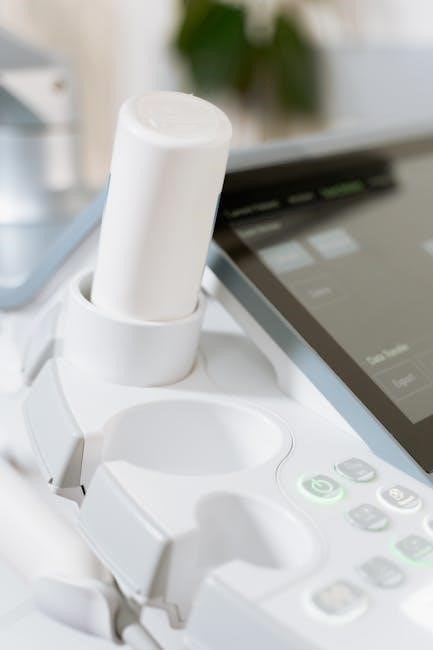The Michigan Alcohol Screening Test (MAST) is a widely recognized tool for assessing alcohol use disorders. It is a self-scoring questionnaire designed to identify potential drinking problems and is available in PDF format for easy access.
1.1 What is the MAST?
The Michigan Alcohol Screening Test (MAST) is a 24-question self-scoring assessment tool designed to evaluate alcohol dependence. It is nationally recognized for its effectiveness in identifying potential drinking problems. The test is simple to use, with yes/no responses, and is available in PDF format for easy access. Developed to provide a quick and reliable screening method, the MAST is widely used in healthcare settings. Each question is assigned a specific point value, and the total score helps determine the severity of alcohol use. A score of 6 or more typically indicates a need for further evaluation. Its ease of use and accuracy make it a valuable resource for both professionals and individuals.
1.2 Importance of Alcohol Screening
Alcohol screening is crucial for early identification of potential drinking problems, enabling timely intervention. The MAST plays a significant role in this process by providing a straightforward and reliable method to assess alcohol use. Early detection helps prevent progression to severe alcohol dependence, reducing health risks and social consequences. Screening is essential in healthcare, legal, and workplace settings to address alcohol-related issues promptly. It promotes awareness and encourages individuals to seek help, ultimately improving outcomes and reducing societal impacts. The MAST’s simplicity and effectiveness make it a valuable tool for fostering proactive health management and supporting individuals at risk of alcohol misuse.

Development and History of the MAST
The Michigan Alcohol Screening Test (MAST) was developed in 1971 by Dr. Melvin L. Selzer. It is a self-scoring tool designed to assess alcohol dependence effectively;
2.1 Creation and Purpose
The Michigan Alcohol Screening Test (MAST) was created in 1971 by Dr. Melvin L. Selzer to identify individuals with potential alcohol use disorders. Its primary purpose is to serve as a diagnostic tool for healthcare professionals, enabling early detection of alcohol dependence. The test consists of a series of yes/no questions that assess various aspects of drinking behavior, such as consumption patterns, social and legal consequences, and physical symptoms. By providing a standardized method of screening, the MAST helps guide further evaluation and treatment for those at risk. Its design ensures simplicity and effectiveness in both clinical and non-clinical settings.
2.2 Evolution Over Time
The Michigan Alcohol Screening Test (MAST) has undergone revisions since its creation in 1971 to improve its effectiveness. The original 24-question format was designed for self-administration, making it accessible for widespread use. Over the years, shorter versions like the SMAST (13 questions) and b-MAST (10 questions) were developed to accommodate different screening needs. These adaptations retained the core elements of the original test while streamlining the process. Additionally, the MAST-G, a geriatric version, was introduced to address alcohol use in older adults. Continuous updates ensure the test remains relevant and effective in identifying alcohol-related issues across diverse populations.

How the MAST Works
The MAST is a self-scoring test where individuals answer yes/no questions about their drinking habits. Responses are summed to determine a score, which helps assess alcohol-related issues.
3.1 Scoring System
The MAST uses a weighted scoring system to assess alcohol use disorders; Each question is assigned a specific point value, with critical items like questions 8, 19, and 20 worth five points. Other questions are valued at two or one point based on their discriminative power. The total score is calculated by summing these points, ranging from 0 to 53. A score of 6 or higher indicates a potential alcohol problem, while scores above 17 suggest severe dependence. This system allows for accurate screening and helps determine the need for further evaluation or intervention. The scoring is straightforward, making it easy to interpret results.
3.2 Different Versions of the Test
The Michigan Alcohol Screening Test (MAST) exists in several forms to cater to different needs. The original MAST includes 24 questions, while the Brief MAST (b-MAST) is a shorter, 10-question version designed for quicker screenings. The Short Michigan Alcohol Screening Test (SMAST) has 13 questions, requiring only a 7th-grade reading level. Additionally, the Geriatric Version (MAST-G) is tailored for older adults, focusing on age-related drinking issues. These variations maintain the core principles of the original test but adapt to specific populations or settings, ensuring versatility and accessibility. All versions aim to identify alcohol use disorders effectively, making them valuable tools in various clinical and non-clinical contexts.

Structure of the MAST
The MAST features 24 YES/NO questions, with select items assigned higher point values (e.g., questions 8, 19, and 20 are worth 5 points each) to assess drinking severity.
4.1 Number of Questions
The Michigan Alcohol Screening Test (MAST) consists of 24 YES/NO questions designed to assess alcohol use and potential dependency. These questions cover various aspects of drinking behavior, including frequency, consequences, and social impact. The test is structured to be straightforward and easy to complete, typically requiring only a few minutes. Each question is scored based on its relevance to alcohol dependency, with certain items carrying higher point values. The total score is calculated by summing the points from all questions, providing a clear measure of alcohol-related issues. This 24-question format ensures a comprehensive yet efficient assessment of drinking patterns and problems.
4.2 Question Format and Examples
The MAST questions are straightforward, requiring a YES or NO response. They cover various aspects of drinking behavior, such as frequency, consequences, and social effects; For example, questions like “Do you enjoy drinking now and then?” assess general attitudes toward alcohol, while others like “Have you ever awakened the morning after drinking and found you couldn’t remember part of the evening?” address specific consequences. Each question is designed to gauge the severity of alcohol-related issues, with certain responses indicating higher risk levels. This format ensures clarity and ease of use, making the test accessible to a broad audience while maintaining its effectiveness in identifying potential problems.

Clinical Applications of the MAST
The MAST is widely used in healthcare settings to identify individuals at risk for alcohol-related disorders. It aids in assessing severity and monitoring treatment progress effectively.
5.1 Use in Healthcare Settings
The MAST is extensively utilized in healthcare settings to screen patients for alcohol-related issues. It is often administered during routine check-ups or when healthcare providers suspect alcohol misuse. The test’s self-scoring nature makes it efficient for quick assessments in busy clinical environments. By identifying individuals at risk, the MAST enables early intervention and referral to specialized care. Its simplicity and effectiveness have made it a valuable tool for physicians, nurses, and counselors. Additionally, the MAST is used in hospitals, clinics, and rehabilitation centers to monitor progress and tailor treatment plans for patients with alcohol use disorders.
5.2 Role in Legal and Workplace Screening
The MAST is also employed in legal and workplace settings to detect alcohol-related issues. In legal contexts, it aids in assessing individuals involved in alcohol-related offenses, providing evidence for court cases. Employers use the MAST to screen job applicants or employees, ensuring workplace safety and productivity. The test helps identify alcohol misuse that could lead to accidents or impair job performance. Its use in these settings supports compliance with regulations and maintains a safe working environment. The MAST’s reliability and brevity make it a practical tool for legal and occupational alcohol screening, contributing to informed decision-making and appropriate interventions.

Interpretation of MAST Scores
MAST scores are interpreted based on a standardized scale to assess alcohol use severity. A score of 6 or higher indicates potential alcohol-related issues. Scores range from 0 to 53, with higher values reflecting more severe dependence. The scoring system categorizes individuals into different risk levels, guiding further evaluation and intervention strategies. This interpretation helps healthcare professionals and legal authorities make informed decisions regarding treatment or monitoring. The MAST score thresholds are widely accepted as reliable indicators of alcohol misuse, enabling effective early intervention and support.
6.1 Scoring Scale and Thresholds
The MAST scoring system ranges from 0 to 53, with higher scores indicating more severe alcohol-related issues. A score of 0-5 suggests no significant alcohol problem, while 6-10 indicates mild issues. Scores between 11-20 suggest moderate alcohol misuse, and 21-26 point to early alcohol dependence. A score of 27-30 indicates middle dependence, and 31-53 reflects late-stage alcohol dependence. Scores above 53 are considered severe and may require immediate intervention. These thresholds help professionals assess the severity of alcohol use disorders and guide appropriate treatment or monitoring strategies. The scoring system is standardized, ensuring consistent interpretation across different settings. Higher scores correlate with greater alcohol-related consequences.
6.2 Implications of Different Score Ranges
MAST scores provide insights into the severity of alcohol-related issues. Lower scores (0-5) suggest no significant alcohol problem, while scores of 6-10 indicate mild issues that may benefit from early intervention. Moderate scores (11-20) suggest alcohol misuse requiring monitoring or counseling. Higher scores (21-26) indicate early dependence, necessitating targeted treatment. Scores of 27-30 reflect middle dependence, often requiring structured programs. Scores above 30 signify severe alcohol dependence, requiring intensive interventions. These ranges help healthcare providers tailor assessments and treatments, ensuring appropriate care based on the severity of alcohol use disorders. Early identification of higher scores can lead to timely interventions, improving outcomes for individuals at risk.

Limitations and Controversies
The MAST has faced criticism for its reliance on self-reporting and potential biases. Some argue it may not accurately detect issues in certain populations or contexts, leading to debates about its effectiveness compared to other screening tools.
7.1 Criticisms of the Test
The MAST has faced several criticisms. One major concern is its reliance on self-reported data, which may lead to underreporting or inaccurate responses. Critics argue that individuals may not answer truthfully due to stigma or denial. Additionally, the test’s scoring system has been questioned for potentially overestimating alcohol dependence in certain populations. Some studies suggest that the MAST may not perform as well in identifying early-stage alcohol use disorders or in non-clinical settings. Furthermore, its effectiveness in assessing alcohol use among different demographic groups, such as adolescents or the elderly, has been debated. These limitations highlight the need for complementary assessments and tools in alcohol screening.
7.2 Comparison with Other Screening Tools
The MAST is often compared to other alcohol screening tools like the CAGE questionnaire, AUDIT, and SMAST. While the CAGE is shorter and focuses on behavioral aspects, the MAST provides a more detailed assessment of alcohol dependence. The AUDIT, developed by the WHO, offers a broader evaluation of alcohol use patterns but is longer than the MAST. The SMAST, a shorter version of the MAST, is often preferred for its brevity while maintaining reliability. Each tool has its strengths, with the MAST being particularly noted for its self-scoring feature and widespread use in clinical settings. However, some critics argue that shorter tools may be equally effective in certain contexts.
Resources for the MAST
The MAST is available in PDF format for self-assessment, with versions like the SMAST-G catering to geriatric populations. Additional guides provide scoring instructions and interpretation support.
8.1 Where to Find the MAST PDF
The MAST PDF is readily accessible online through various health and academic websites. It can be downloaded from sources like the University of Michigan, SAMHSA, and medical portals. Ensure to use Adobe Acrobat for viewing and printing. The test is available in different versions, including the SMAST and SMAST-G, tailored for specific populations. Additionally, some sites offer guides and scoring instructions alongside the PDF to facilitate self-assessment and interpretation. Always verify the source for accuracy and reliability when accessing the MAST PDF to ensure you receive the correct and official version of the test.
8.2 Additional Materials and Guides
Beyond the MAST PDF, supplementary materials are available to enhance understanding and administration. These include scoring guides, interpretation manuals, and user instructions. Many websites offer detailed explanations of each question and scoring criteria. Additional resources, such as the SMAST and SMAST-G versions, cater to specific demographics. Guides often provide cutoff scores and thresholds for identifying alcohol-related issues. These materials are essential for healthcare professionals and individuals seeking to interpret results accurately. They ensure the test is used effectively in both clinical and self-assessment settings, promoting reliable outcomes and informed decision-making regarding alcohol use concerns.
